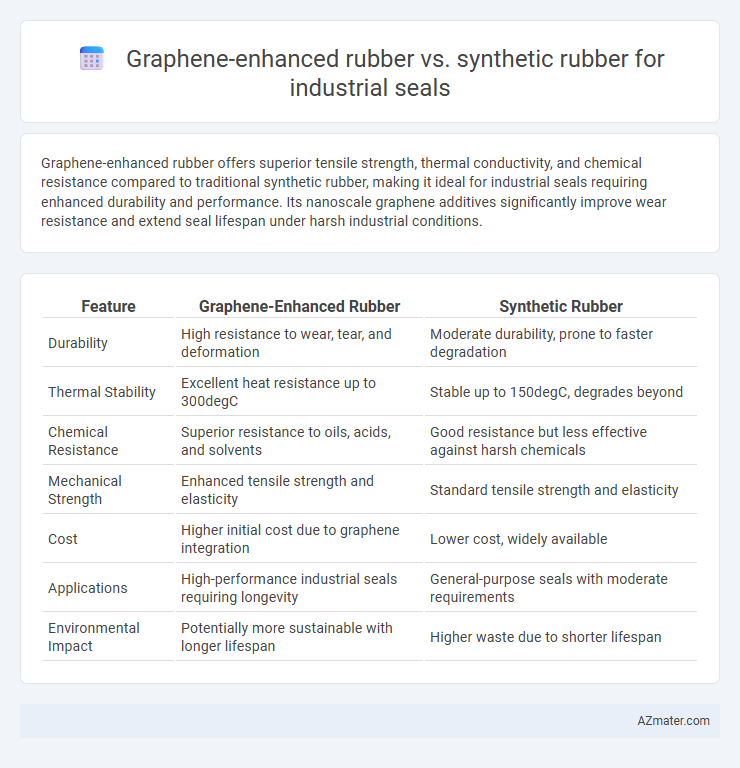Graphene-enhanced rubber offers superior tensile strength, thermal conductivity, and chemical resistance compared to traditional synthetic rubber, making it ideal for industrial seals requiring enhanced durability and performance. Its nanoscale graphene additives significantly improve wear resistance and extend seal lifespan under harsh industrial conditions.
Table of Comparison
| Feature | Graphene-Enhanced Rubber | Synthetic Rubber |
|---|---|---|
| Durability | High resistance to wear, tear, and deformation | Moderate durability, prone to faster degradation |
| Thermal Stability | Excellent heat resistance up to 300degC | Stable up to 150degC, degrades beyond |
| Chemical Resistance | Superior resistance to oils, acids, and solvents | Good resistance but less effective against harsh chemicals |
| Mechanical Strength | Enhanced tensile strength and elasticity | Standard tensile strength and elasticity |
| Cost | Higher initial cost due to graphene integration | Lower cost, widely available |
| Applications | High-performance industrial seals requiring longevity | General-purpose seals with moderate requirements |
| Environmental Impact | Potentially more sustainable with longer lifespan | Higher waste due to shorter lifespan |
Introduction to Industrial Seal Materials
Graphene-enhanced rubber offers superior mechanical strength, thermal conductivity, and chemical resistance compared to traditional synthetic rubber in industrial seal applications. The inclusion of graphene nanoparticles significantly improves durability, wear resistance, and sealing performance under extreme conditions. Synthetic rubber remains widely used due to cost-effectiveness and versatility, but graphene-enhanced variants deliver enhanced longevity and efficiency for high-demand sealing environments.
Overview of Synthetic Rubber in Sealing Applications
Synthetic rubber, widely used in industrial sealing applications, offers excellent resistance to heat, chemicals, and abrasion, making it suitable for harsh operational environments. Common types such as nitrile (NBR), EPDM, and silicone rubber provide versatile mechanical properties and durability, ensuring reliable sealing performance across various industries. Advances in synthetic rubber formulations have enhanced elasticity and temperature tolerance, but challenges in wear resistance and environmental impact remain compared to emerging materials like graphene-enhanced rubber.
Emergence of Graphene-Enhanced Rubber Technologies
Graphene-enhanced rubber offers superior mechanical strength, thermal conductivity, and chemical resistance compared to traditional synthetic rubber, making it highly suitable for industrial seal applications. The emergence of graphene-enhanced rubber technologies leverages graphene's exceptional tensile strength and flexibility, significantly improving seal durability and lifespan under harsh operating conditions. Industrial sectors adopting graphene-enhanced rubber report enhanced performance in extreme environments, reduced wear and tear, and greater cost-efficiency over synthetic rubber alternatives.
Mechanical Strength Comparison: Graphene vs Synthetic Rubber
Graphene-enhanced rubber exhibits significantly higher mechanical strength compared to conventional synthetic rubber, with tensile strength improvements up to 50% due to graphene's exceptional atomic structure and load transfer capabilities. The integration of graphene enhances elasticity and abrasion resistance, making it ideal for industrial seals subjected to harsh mechanical stress and dynamic loading. Synthetic rubber, while versatile and cost-effective, generally lacks the superior durability and reinforcement properties that graphene nanomaterials provide in sealing applications.
Chemical Resistance and Durability Analysis
Graphene-enhanced rubber exhibits superior chemical resistance compared to traditional synthetic rubber, effectively withstanding exposure to aggressive solvents, oils, and acids common in industrial seal applications. Its enhanced durability is attributed to the exceptional tensile strength and elasticity imparted by graphene nanoparticles, resulting in longer service life and reduced maintenance costs. Synthetic rubber seals, while cost-effective and versatile, often suffer degradation under harsh chemical environments and mechanical stress, limiting their performance in demanding industrial operations.
Temperature and Environmental Stability
Graphene-enhanced rubber exhibits superior temperature resistance, maintaining elasticity and performance in extreme heat ranges up to 400degC, compared to synthetic rubber's typical stability limit of around 150degC. The integration of graphene significantly boosts environmental stability by enhancing resistance to oxidation, UV degradation, and chemical exposure, extending the lifespan of industrial seals in harsh conditions. Industrial seals made from graphene-enhanced rubber deliver improved durability and reliability in fluctuating temperature environments and aggressive chemical atmospheres, surpassing conventional synthetic rubber seals.
Cost-Benefit Assessment for Industrial Use
Graphene-enhanced rubber offers superior mechanical strength, chemical resistance, and thermal stability compared to traditional synthetic rubber, significantly extending the lifespan of industrial seals and reducing maintenance costs. Although its initial cost is higher, the enhanced durability and performance lead to lower total cost of ownership, especially in demanding industrial applications such as oil and gas, mining, and heavy machinery. Cost-benefit assessment shows that graphene-enhanced rubber delivers improved return on investment through decreased downtime and fewer seal replacements, justifying its premium price for long-term industrial use.
Performance in High-Pressure Environments
Graphene-enhanced rubber exhibits superior tensile strength and improved chemical resistance compared to traditional synthetic rubber, making it highly suitable for industrial seals in high-pressure environments. Its enhanced thermal conductivity and exceptional durability reduce wear and deformation, extending seal lifespan under extreme conditions. These properties result in better leakage prevention and consistent sealing performance, critical for maintaining safety and efficiency in hydraulic and pneumatic systems.
Sustainability and Environmental Impact
Graphene-enhanced rubber offers superior sustainability benefits over conventional synthetic rubber due to its increased durability, which reduces the frequency of seal replacements and waste generation in industrial applications. The enhanced mechanical properties of graphene composites also enable lower material consumption and energy use during production, significantly minimizing the carbon footprint compared to traditional synthetic rubber seals. Furthermore, graphene's potential for recyclability and reduced reliance on petrochemical-based raw materials promotes a more environmentally friendly lifecycle for industrial sealing solutions.
Future Trends in Rubber Sealing Materials
Graphene-enhanced rubber demonstrates superior mechanical strength, thermal conductivity, and chemical resistance compared to traditional synthetic rubber, making it a promising material for advanced industrial seal applications. Future trends indicate a shift towards integrating nanomaterials like graphene to improve durability, reduce wear, and extend the operational lifespan of seals in harsh environments. Research continues to focus on scalable production methods and optimizing composite formulations to achieve enhanced performance and cost efficiency in rubber sealing materials.

Infographic: Graphene-enhanced rubber vs Synthetic rubber for Industrial seal
 azmater.com
azmater.com